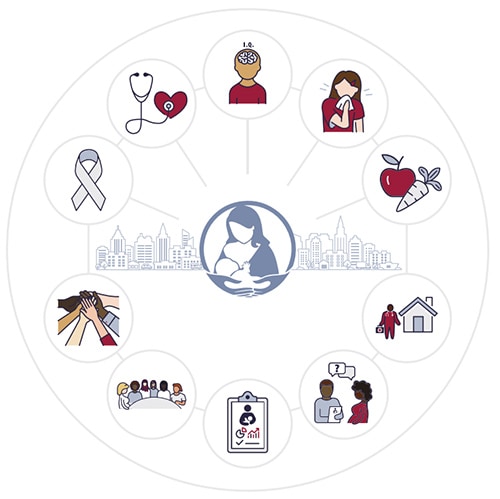
Priority Breastfeeding Strategy: Continuity of Care
Implement policies and activities that achieve continuity of care for breastfeeding families.
Background
Continuity of Care in breastfeeding is achieved by consistent, collaborative, and seamless delivery of high-quality services from the prenatal period until families are no longer breastfeeding. Continuity of care results in transitions that are coordinated and fully supportive of families throughout their breastfeeding journey.
Breastfeeding has many health benefits for infants, children, and mothers. Federal [PDF-30.7MB] and professional recommendations are for infants to be exclusively breastfed for about the first 6 months. Yet many families stop breastfeeding earlier than they planned. Breastfeeding disparities by race, ethnicity, and socioeconomic status persist. Infants less likely to be breastfed include non-Hispanic Black infants and those living in lower income households or rural areas.
Multiple factors can influence a person’s ability to start and continue breastfeeding. These factors are wide ranging and might include a lack of access to community breastfeeding support or encounters with providers who are untrained in the clinical evaluation and management of breastfeeding problems.
Communities, workplaces, childcare agencies, hospitals, health care providers, lactation support providers, and related social support service providers can make breastfeeding attainable and easier. Eliminating disparities in breastfeeding support is fundamental to reaching health equity so every infant can have optimal nutrition. When systems of care align to support breastfeeding, states and communities can better address the unique barriers facing their specific population.
Potential Activities
State
* Designates short-term activities that can generally be accomplished in 1 to 2 years.
+ Designates long-term activities that may take up to 5 years.
*+ Designates activities that may be short- or long-term, depending on the organization’s capacity, previous work in this area, and size of the project.
Work with partners to:
- Use CDC data sources to help identify gaps and needs in your state.*+ Examples include:
- Identify opportunities for state and local breastfeeding coalitions, community organizations, and groups that represent the population to carry out comprehensive, high-quality, seamless breastfeeding support programs and services, especially among populations most at risk for not breastfeeding.*+
- Collaborate with hospitals to identify opportunities and carry out interventions to improve maternity care practices supportive of breastfeeding.*+
- Help clinics and provider offices develop a written breastfeeding-friendly office [PDF-433KB] policy and implement practices that can improve breastfeeding rates by meeting the unique needs of their patients. Learn more in Tools from State Programs and What Others Are Doing. Also see:*
- Provide employers with resources and technical assistance to help them comply with federal and state regulations on lactation support in the workplace and share examples of how the federal law can be put into action in a variety of work settings. Adapt and disseminate materials to educate employers about the benefits of providing comprehensive, high-quality support for lactating employees.*
- Plan and conduct a summit of key state and local decision makers in workplaces, hospitals, clinics, child care agencies, communities, and government to address ongoing challenges to comprehensive, connected, and high-quality lactation support.*
- Assess opportunities for ECE centers to support breastfeeding by meeting licensing regulations from the National Resource Center for Health and Safety in Child Care and Early Education such as:
- Support breastfeeding during child care hours.
- Recommend that staff or parents feed breast milk.
- Require comfortable arrangements for mothers to breastfeed or express milk on-site.*+
Find more breastfeeding and ECE resources on the Early Care and Education Resource Library page.
- Improve the capacity to deliver culturally relevant breastfeeding services in communities most at risk of not breastfeeding by training all individuals who service the family unit to work collaboratively to provide consistent, tailored, equitable, and evidence-based lactation education and support.*+
- Coordinate breastfeeding support training to diversify the lactation workforce, increase the number of lactation support providers who represent communities with low breastfeeding rates, and facilitate continuing education for these providers.*+
Local
- Review Continuity of Care in Breastfeeding Support; a Blueprint for Communities (Blueprint) to identify which recommendation(s) are best suited for your community. Examples of activities that support these recommendations are found in the Blueprint. Priority recommendations from the Blueprint include:
- Create community environments that proactively promote, protect, and support chest/breastfeeding. This can be done in spaces where families live, work, play, worship, shop, travel, receive services, and raise children.*+
- Increase the community’s ability to provide consistent, tailored, evidence-based lactation education and support by regularly training anyone who provide services to families.*+
- Provide family-centered lactation care that responds to the family’s multiple identities, their social determinants of health, and other factors related to their infant feeding journey.*+
- Implement a care coordination system that begins with the prenatal period and continues through weaning stages. The system can include formal referral systems, follow-up accountability, and hand-off protocols during transitions of lactation care from one provider or setting to another.*+
Resources
Baby-Friendly USA Guidelines and Evaluation Criteria
Used to coordinate and conduct activities necessary to achieve the Baby-Friendly designation. Describes standards of maternity care that hospitals should strive to achieve, and includes the Ten Steps to Successful Breastfeeding.
CDC Guide to Strategies to Support Breastfeeding Mothers and Babies
[PDF-1.97MB] Information to help state and local communities choose the breastfeeding intervention strategy that best meets their needs.

Continuity of Care in Breastfeeding Support; a Blueprint for Communities (Blueprint)
How local organizations and individuals can interact with pregnant and postpartum families to increase community capacity to support breastfeeding. The approach is centered on the needs of populations most affected by structural barriers that lead to low rates of breastfeeding.
EMPower Training Initiative
Resource to improve evidence-based maternity practices supportive of optimal infant feeding.
Illinois Public Health Institute’s Improving Lactation Support & Continuity of Care [PDF-2.3MB]
Strategy examples for institutions, including health care, community organizations, schools, and worksites.
mPINC Ten Steps Assessment Tool
Tool to assess a hospital’s implementation of each of the Ten Steps to Successful Breastfeeding. Helps guide maternity care practices and policies supportive of breastfeeding and identify and prioritize quality improvement efforts.
Physician Education and Training to Support Breastfeeding
Resources to increase the availability and accessibility of medical provider education and training. Designed to improve capacity of medical providers to facilitate evidence-based care with their practices and promote continuity of breastfeeding-related care in the community.
Practitioner’s Guide for Advancing Health Equity: Breastfeeding Practices and Policies [PDF-1.41MB]
Provides equity-oriented considerations, key partners, and community examples related to the design and implementation of supportive breastfeeding strategies. Improving the initiation, exclusivity, and duration of breastfeeding may involve addressing hospital practices, supporting workplace accommodations, and building supportive community environments. See additional health equity resources.
Removing Barriers to Breastfeeding [PDF-3.3MB]
Highlights barriers women face during pregnancy, at the hospital, and postpartum. One barrier is that communities most at risk of not breastfeeding often lack Baby-Friendly hospitals and certified lactation consultants.
The Role of Law & Policy in Assisting Families to Reach Healthy People’s Maternal, Infant, and Child Health Breastfeeding Goals in the United States [PDF-1.86MB]
Report to increase awareness of the roles law and policy play in improving health.
The Surgeon General’s Call to Action to Support Breastfeeding (pages 70–77)
Steps state and local governments can take to increase mother-to-mother and professional support. Includes action steps for multiple sectors and settings.
What Others Are Doing
Voices of Black Mothers: The Baby-Friendly Experience [PDF-1.12MB]
Report from Missouri and Uzazi Village in Kansas City identifies and addresses the gaps in hospital care when comparing the experiences of Black mothers to Baby-Friendly hospital standards.
Local Communities Implementing the Continuity of Care in Breastfeeding Support Blueprint
Ten local organizations and their community partners implemented two or more recommendations from the Continuity of Care in Breastfeeding Support: A Blueprint for Communities to improve the local breastfeeding landscape in communities of racial and ethnic groups. This resource outlines project implementations, successes, challenges, and lessons learned.
Washington State Department of Health’s Lactation and Infant Feeding-Friendly Environments Hospital Program
This voluntary designation program recognizes the important role hospitals play in supporting breastfeeding.
Definitions
Lactation Support Provider [PDF-189MB] includes those trained in providing support to individuals who are lactating. Lactation support providers include lactation consultants, breastfeeding counselors, breastfeeding peer counselors and lactation educators.
Maternity Care Practices supportive of breastfeeding take place during the labor and delivery in a hospital stay and include practices and policies related to prenatal care, care during labor and birthing, and postpartum care.


